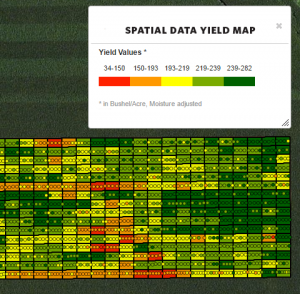Not seeing any perks from traditional plot data? You just might be in the market to put your corn fields into a spatial data trial.
“Today most states in the corn growing region have some emphasis on spatial data collection,” said Lance Tarochione, DEKALB Asgrow technical agronomist in Illinois. “The biggest change in the process in recent years has to do with the analysis of the data rather than the collection of the data.”
Spatial data trials are much larger than a traditional trial plot, typically a quarter- to half-mile long. Technical agronomists monitor these trials closely throughout the growing season, taking notes on emergence and early growth, disease differences throughout the year, ear fill characteristics, and finally standability late season.
In Tarochione’s home state, the DEKALB team conducts approximately 140 spatial trials each year and many are repeat customers.
“Farmers tell us the data is interesting and beneficial and they have learned a lot as cooperators in the program. Farmers like the opportunity to see our newest genetics on their farm a year before they can buy them,” Tarochione said. “Farmer cooperators also like being the first people to see the results of the trials and gain first hand insights into product positioning and performance.”
At harvest, utilizing a well-calibrated combine yield monitor, data is collected every two or three seconds as the combine travels across the field. GPS yield points are geo-referenced to the particular environment that generated them.
Unlike a single yield number with traditional trial plots, spatial data monitoring can result in several hundred yield results within the field. Data is analyzed from multiple spatial data locations across numerous, regional geographies.
Two years ago, a Monsanto Technology Development researcher developed a database tool where agronomists can query the spatial data they have been collecting.

“This greatly enhanced our ability to mine the database and gain insights into product performance,” Tarochione said. “Prior to that we had been accumulating data but the methods we had to analyze the data were limited and slow.”
The integration of Climate FieldView has also aided in the data sharing, visualization, and analysis of spatial data.
“With technology advancements, today’s yield monitors are easier to use, easier to calibrate, and should improve the accuracy of the data we collect from them,” Tarochione said. “With weather monitoring tools like Climate we also have a better understanding of the environment at the field level which can also improves the process.”
Even with the improvements in data collection, Tarachione said selecting the right field is a critical component. Not just any field is suited for a spatial trial.
“There are also some equipment requirements and a finite number of locations due to seed supply and workload limitations,” Tarachione said. “If a grower thinks they would like to be involved they could contact their DEKALB dealer or local DSM to see if they have a need for an additional location.”
Another perk of spatial data trials Tarachione said is that farmers should not feel that they need to participate personally. After all, it is the seed supplier’s responsibility to the farmer.
“As more and more farmers have planting equipment that is capable of variable rate and even multi-hybrid seeding, understand hybrid performance on a sub-field environmental basis has increased in value and importance,” Tarachione said. “If a farmer has invested in equipment technology that has these capabilities, they have an expectation of their seed supplier to be able to provide them population, placement, and management information by hybrid. Collecting hybrid performance data spatially is a critical step in this process and can help farmers maximize the ROI on their seed and equipment purchases.”



